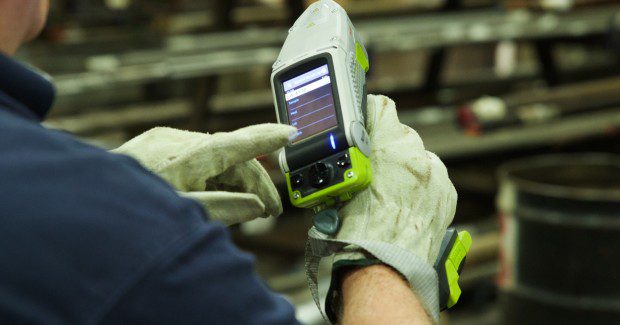Lightweighting Absence of Malice: Inspecting for Tramps
Alloys from lighter-weight metals like aluminum, titanium and magnesium have chemical compositions that must be verified to ensure the absence of tramp elements that can lead to significant problems. This groundbreaking inspection technology identifies the amount of each element in an alloy – right on the shop floor.
Posted: March 2, 2016
The automobile manufacturing industry is in the midst of a significant transformation, and the latest trends have opened the door for breakthrough, handheld technology to play a critical role in ensuring that manufacturers know the exact make-up of the cars they are building. For the last century, auto suppliers have relied on steel as the dominant car-building material. The Steel Recycling Institute (Pittsburgh, PA) estimates that the typical passenger car is made up of 60 percent steel, a strong and durable material, but also a material that increases the weight of a car, impacting fuel economy and emissions standards. Aluminum has entered the picture as a lighter-weight alternative that allows manufacturers to meet the far more stringent regulations that are on the horizon, such as fuel economy standards set by the U.S. Environmental Protection Agency (EPA). The EPA target for improvement in average automobile fuel efficiency is 54.5 miles per gallon by 2025.
But the drawback is that the alloy chemistries associated with aluminum and other metals, such as magnesium and titanium alloys, are far more complex – and require greater analytical oversight – than those associated with steel. As a result, X-ray fluorescence (XRF) technology is increasingly being adopted in the auto making industry as a way to understand which elements are being incorporated into the making of a car – on the spot, and in real time.
BEHIND THE TECHNOLOGY
The leading XRF spectroscopy instruments on the market include handheld XRF analyzers that are built around several core characteristics that benefit all users, especially those in auto manufacturing. They are small and lightweight, so they can be used in tight spots; they are fast, providing instantaneous results that don’t require lab testing; and they are simple to use – the smarts are built into the instrument, allowing a non-expert spectroscopist on the manufacturing floor to point, shoot and obtain metal alloy chemistry. These analyzers also have the ability to quantify a coating/plating thickness including passivation, conversion and electro-plating.
Handheld XRF spectroscopy technology incorporates an X-ray, a detector (silicon drift detector, or SDD), a digital signal processor, a central processing unit and a data storage device. When a user points and shoots, a miniaturized X-ray tube sends a primary X-ray beam into the sample, and upon impact, energy is released in the form of fluorescent X-rays. These fluorescent X-rays are measured by the detector, which can identify and quantify the element or elements. Within seconds, the instrument displays the concentration of each element and also calculates the total concentration in order to instantaneously identify the alloy, utilizing an on-board alloy library. The technology can simultaneously identify 30 of the most common elements, and can detect elements as light as magnesium to those as heavy as uranium.
IMPACT ON AUTO MANUFACTURING
How does the auto industry benefit from this technology, which has improved by leaps and bounds even within the last 18 months? Unlike steel, which is made up almost entirely of iron, alloys from lighter-weight metals like aluminum, titanium and magnesium – all being used more and more in auto manufacturing – have varied and specific chemical compositions. Those compositions must be verified to ensure the absence of residual elements, also known as tramp elements, which are not supposed to be part of the alloy in question and which can lead to significant problems.
The XRF analyzer will identify and display the specific percentages of each element detected in an alloy. For example, if the analyzer detects aluminum alloy 5052 (AA 5052), it will display the percentage of each element identified – ranging from over 96 percent aluminum to approximately 2.5 percent magnesium to less than one percent each of several other elements, such as chrome, nickel and copper. Those percentages are cross-referenced with the on-board library, which knows the chemical composition, or recipe, that is supposed to be in the alloy – and, just as importantly, knows what is not supposed to be in the alloy.
Metal used in car manufacturing is made from melting down recycled scrap metal, and it can be difficult to control what is in that scrap metal. Trace percentages of tramp elements in an alloy can lead to accelerated corrosion, an inability to bond or weld materials and numerous additional complications that can also lead to increased costs in automobile production. If the analyzer detects a tramp element in what is definitively recognized as AA 5052, for instance, the user will know immediately and can make production decisions accordingly. As analyzers have continued to evolve, their limits of detection have decreased; in other words, they can analyze lower levels of each element.
INDUSTRY TRANSFORMATION
XRF technology is still quite new to the automotive industry, which only recently has felt the urgency to adopt new testing techniques to verify the makeup of their manufacturing materials. Handheld XRF instruments are now also being used in other ways within auto manufacturing, such as to analyze the thickness of passivation coatings. There are distinct time and cost savings that can be attributed to the use of portable analytical technology in this field. Auto makers generally don’t have on-site laboratories. Without the ability to accurately and reliably test on the spot, in a non-destructive manner, shops would require samples to be sent to outside labs, with results taking days. There are high costs associated with lab usage – costs that are not incurred with a handheld analyzer that incorporates lab-grade spectroscopy.
As manufacturers continue to trend away from steel and toward light-weight materials, and as the industry inches closer to the date by which new regulations will have a direct effect on the makeup of these materials, adoption of leading portable technology is critical. With handheld XRF analyzers, real-time data is at the finger-tips of the shops that are manufacturing the vehicles of tomorrow.














